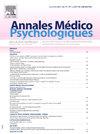依恋综合治疗持续性抑郁症的试点研究
IF 0.5
4区 医学
Q4 PSYCHIATRY
引用次数: 0
摘要
持续性抑郁障碍(PDD)是DSM-5中新提出的一种将慢性重度抑郁症的诊断与心境恶劣相结合的疾病。与典型的抑郁发作相比,PDD的特点是对生活质量的负面影响更明显,住院和自杀未遂的风险更大,通常发病更早,持续时间为几年至几十年。PDD的治疗面临着很高的治疗失败率或部分缓解率。在心理治疗方面,唯一适合慢性抑郁症的特定心理治疗是心理治疗的认知行为分析系统(CBASP)。最初的试验表明,它的效果与抗抑郁药相当,并且与药物联合使用时疗效显著提高。然而,随后的试验显示出不同的结果。到目前为止,PDD似乎没有任何已知的有效治疗抑郁症的方法。可以解释这种缺乏结果的假设之一是依恋不安全感。事实上,依恋不安全感越来越多地在文献中被解决,而在传统疗法中却没有被考虑到。虽然抑郁症的起因是多因素的,但我们现在知道,不安全的依恋是导致抑郁症的一个主要风险因素。在以往的研究中,不安全依恋与长期抑郁显著相关。考虑到这一点,依恋综合疗法从一种基于依恋的方法适应于PDD。我们认为有必要将依恋维度整合到这个概念中,因为我们提出了关系问题,特别是那些起源于早期关系的问题。AIT是一种有时间限制的治疗方法,用于支持有不安全依恋的客户,他们的安全需要直接和深刻的依恋重组。AIT主要关注依恋系统激活的基础(在与依恋对象的关系受到威胁的情况下),即自我和他人的表现,通过研究自信和对他人的信心的概念及其与自尊的联系。其次,通过使患者发展依恋互动技能。为了实现这两个目标,美国在台协会是按照鲍比的建议制定的。虽然鲍尔比并没有在他的理论基础上开发出一种治疗方法,但他还是确定了五个治疗任务,可以指导依恋导向的治疗师塑造他们的工作。本研究的目的是评估AIT在治疗开始(T1)、治疗结束(T2)和治疗后一年(T3)三个层面上对PDD的影响:抑郁症状、依恋不安全感和社会支持。这项研究包括11名患有PDD的病人,他们在巴黎圣安妮医院的门诊进行了随访。评估分三个层面进行:抑郁症状(MINI, BDI-II),依恋(RSQ)和社会支持(SSQ6)。三次评估的BDI-II结果显示出一种进化,在治疗开始和结束之间,抑郁评分平均降低了50%。此外,依恋不安全感表现在依恋风格、自我和他人的表征上,也随着在台研修而改善。第三阶段的结果显示,即使我们在第三阶段发现抑郁症状有所增加,但在治疗结束一年后,AIT仍然对抑郁症状、自我表征和社会支持有帮助。然而,这种增加在统计上并不显著,我们可以得出结论,AIT在1年后仍然有效,没有复发。在自我表征方面,我们发现T1和T2之间的分数有所增加,T2和T3之间的分数趋于稳定。这表明,在治疗一年后,AIT继续对自我形象产生影响。然而,这种改善在其他人的表现中没有发现,我们发现T1和T2之间有改善,即使它并不显著。然而,T2和T3之间得分下降。关于最后一个变量,我们注意到参与者在T1和T3之间感知到的可用性有所改善,平均水平有所提高。在满意度方面,我们也注意到T3的显著改善。门诊AIT项目的发现和结果是有希望的。此外,本研究表明,依恋系统的慢性激活可能是抑郁持续性障碍发展的一个预测因子。因此,在治疗抑郁症持续性障碍时,应注意依恋问题。本文章由计算机程序翻译,如有差异,请以英文原文为准。
Thérapie Intégrée d’Attachement pour le trouble dépressif persistant : une étude pilote
Persistent depressive disorder (PDD), newly developed in DSM-5, merges the diagnoses of chronic major depressive disorder with that of dysthymia. In comparison with the characterized depressive episode, PDD is distinguished by a more marked negative impact on the quality of life, a greater risk of hospitalization and suicide attempts, an often-earlier onset, and a duration of several years to several decades. The treatment of PDD is faced with a high rate of treatment failure or partial remission. In terms of psychotherapy, the only specific psychotherapy adapted to chronic depression is the Cognitive-Behavioral Analysis System of Psychotherapy (CBASP). The initial trial showed that it had effects comparable to those of antidepressants and significantly increased efficacy when combined with medication. Subsequent trials, however, showed mixed results. Until now, PDD does not seem to answer to any know validated therapy for depression. One of the hypotheses that can explain this lack of results is attachment insecurity. Indeed, attachment insecurity is increasingly tackled in literature without being taken into consideration in conventional therapies. Although depression is multifactorial in origin, we now know that insecure attachment is a major risk factor for developing depression. In previous studies, insecure attachment is significantly associated with long-term depression. Considering this, the Attachment Integrated Therapy was adapted for PDD from an attachment-based approach. We felt it was essential to integrate the attachmental dimension in this conception since we raise relational problems, especially those that originate in early relationships. AIT is a time-limited therapy that was developed to support clients with insecure attachment whose security requires a direct and profound restructuring of attachment. AIT focuses mainly on what underlies the activation of the attachment system (in the event of threats to the relationship with the attachment figure), namely the representations of the self and of others by working on the concepts of self-confidence and confidence in others and their link with self-esteem. Secondarily, by enabling the patient to develop attachment interaction skills. To achieve these two objectives, the AIT was developed in line with Bowlby's recommendations. Although Bowlby did not develop a therapy founded on his theory, he nevertheless identified five therapeutic tasks that can guide the attachment-oriented therapist in shaping their work. The purpose of the study was to assess the results of AIT on PDD, found at the beginning (T1) at end of therapy (T2), and one year after therapy (T3) on three levels: depressive symptoms, attachment insecurity and social support. This study included eleven clients, suffering from PDD followed in an outpatient setting, at the Sainte-Anne hospital in Paris. The assessments were conducted on three levels: Depressive symptomatology (MINI, BDI-II), Attachment (RSQ) and Social Support (SSQ6). The BDI-II- results over the three assessment times show an evolution, with an average reduction of depressive scores of 50% between the beginning and the end of the therapy. In addition, attachment insecurity as reflected in attachment styles as well as representations of self and others also improves with the AIT. The results at T3 shows the AIT is still helpful with the depressive symptoms, the self-representations, and the social support 1 year after the therapy completion even if we found an increase in the depressive symptoms at T3. However this increase, not being statistically significant, we can conclude that AIT still works 1 year after without speaking of relapse. Concerning the representation of self, we found an increase in the scores between T1 et T2 and a stabilization between T2 and T3. This shows that AIT continues to have an effect on the image of self, one year after therapy. However this improvement is not found in the representation of others, we found an improve between T1 and T2 even if it was not significant. However, the scores decrease between T2 and T3. Concerning the last variables, we noticed an improvement in the availability perceived by the participants between T1 and T3 with an improvement of the average mean. Regarding satisfaction, we also notice a significant improvement in T3. The findings and outcomes of the outpatient AIT program are promising. Moreover, this study suggests that chronic activation of the attachment system may be a predictor of the development of depressive persistent disorder. When treating depressive persistent disorder, attachment should therefore be addressed.
求助全文
通过发布文献求助,成功后即可免费获取论文全文。
去求助
来源期刊

Annales medico-psychologiques
医学-精神病学
CiteScore
1.30
自引率
33.30%
发文量
196
审稿时长
4-8 weeks
期刊介绍:
The Annales Médico-Psychologiques is a peer-reviewed medical journal covering the field of psychiatry. Articles are published in French or in English. The journal was established in 1843 and is published by Elsevier on behalf of the Société Médico-Psychologique.
The journal publishes 10 times a year original articles covering biological, genetic, psychological, forensic and cultural issues relevant to the diagnosis and treatment of mental illness, as well as peer reviewed articles that have been presented and discussed during meetings of the Société Médico-Psychologique.To report on the major currents of thought of contemporary psychiatry, and to publish clinical and biological research of international standard, these are the aims of the Annales Médico-Psychologiques.
 求助内容:
求助内容: 应助结果提醒方式:
应助结果提醒方式:


